This site uses cookies as defined in our Cookie Policy, by continuing to use this site you agree to their use.
Continue
| Arrive | Depart | ||||||
| 3rd03 | MayMay | 202525 | Siem Reap, Cambodia, embark on the Scenic Spirit | ||||
Welcome to Cambodia and the regional city of Siem Reap. Your hotel, is a step back in time in the definition of luxury and will be your historical home for the next three nights in Siem Reap. This brilliantly appointed accommodation is styled with a mix of French inspired architecture, local interior furnishings and amenities fit for royalty with the attentive staff providing a service beyond expectations. Enjoy the day at leisure until tonight when you meet your Scenic Tour Director and fellow travelling companions at your welcome briefing and dinner. | |||||||
| 4th04 | MayMay | 202525 | Siem Reap, Cambodia | ||||
Your Siem Reap exploration starts with a delicious champagne buffet breakfast at the hotel. Freechoice: As part of Scenic’s Freechoice you have multiple options to choose from. Later this afternoon explore Angkor Wat itself, the largest religious monument in the world. Originally constructed as a Hindu temple dedicated to the god Vishnu for the Khmer Empire, it was gradually transformed into a Buddhist temple towards the end of the 12th century. An afternoon visit provides the perfect light for those idealic pictures of this colossal structure. This evening head to the colourful Cambodian Phare Circus where your VIP premium reserved seating awaits you. Beautifully dressed performers style a stunning show that is more than just a circus. The performers use theatre, music, dance and modern circus arts to tell uniquely Cambodian stories; historical, folk and modern. | |||||||
| 5th05 | MayMay | 202525 | Siem Reap, Cambodia | ||||
Enrich After breakfast, visit the atmospheric, jungle covered Ta Prohm Temple, before stopping at Angkor Thom and the multi-faced Bayon Temple. Fortunately, you have the remainder of the afternoon to discover more of the Siem Reap markets or relax at your luxury hotel after your early morning start. Enrich | |||||||
| 6th06 | MayMay | 202525 | Siem Reap, Cambodia | ||||
Discover the rural side of Cambodia as your coach will transfer you to Kampong Cham where the breathtaking Scenic Spirit awaits. Before arriving, you will be visiting the stunning Khmer bridge at Kampong Kdei, Kampong Thom and a stone cutters village. After boarding, begin your cruise in style with a cocktail reception hosted by your Cruise Director. Take a stroll around the decks to orientate yourself as to where all the amenities are. After your welcome dinner, settling into your private suite does not mean you settle for service. At any time, your dedicated personal butler is free to swing by with a nightcap and delivery of your preferred pillows. | |||||||
| 7th07 | MayMay | 202525 | Kampong Cham, Cambodia | ||||
Awake as you approach Wat Hanchey, an ancient hilltop pagoda and monastery. After learning about life as a novice monk from one of the locals, wander around the complex and admire the view over the Mekong River and surrounding countryside. Sail back to Kampong Cham. Freechoice: Back in Kampong Cham, your Scenic Freechoice excursions this afternoon provides the chance to learn about the history and industries of the area. Your first option is to learn about the local folklore with stops at Phnom Pros (Man Hill and Wat Nokor). Phnom Pros was part of a traditional local legend but more recently was used as a Killing Field during the Khmer Rouge era. The temple now features a Buddha garden and is home to a local troop of monkeys. Wat Nokor Bachey is a unique architectural experiment blending an Angkorian era temple with a new temple built inside it. Alternatively you can explore Kampong Cham’s history and industry with a drive past shop houses, remnants of the French colonial era and the large Central Market. Visit a local rubber plantation established by the French, followed by a tour to view the processing of the raw rubber at a rubber factory before stopping at a village known for growing betel nut, a popular item in Cambodian culture. Once back on board Scenic Spirit, enjoy some time to unwind in your spectacular suite. Your dedicated butler can arrange for a beautiful meal to be served in your suite as you enjoy the sights and sounds of the Mekong, overlooking the gorgeous sunset of the Cambodian skyline as you sail to Angkor Ban. | |||||||
| 7th07 | MayMay | 202525 | Kampong Cham, Cambodia | ||||
| 8th08 | MayMay | 202525 | Angkor Ban, Cambodia | ||||
Upon arrival in Angkor Ban, explore its historical rural wooden houses, which survived the Khmer Rouge and visit a local pagoda where a private and solemn excursion at a Buddhist pagoda awaits. Enrich Afterwards return to Scenic Spirit for lunch and sail downstream to the island of Oknha Tey, where residents are dedicated to the art of silk weaving. Travel by tuk tuk to the farm and learn about the process of silk production. Return to Scenic Spirit where you may wish to absorb more about the local culture with our team by learning how to make and wear the Cambodian scarf. Sunset Drinks | |||||||
| 8th08 | MayMay | 202525 | Phnom Penh, Cambodia | ||||
Phnom Penh, Cambodia’s busy capital, sits at the junction of the Mekong and Tonlé Sap rivers. It was a hub for both the Khmer Empire and French colonialists. On its walkable riverfront, lined with parks, restaurants and bars, are the ornate Royal Palace, Silver Pagoda and the National Museum, displaying artifacts from around the country. At the city’s heart is the massive, art deco Central Market. | |||||||
| 8th08 | MayMay | 202525 | Phnom Penh, Cambodia | ||||
Phnom Penh, Cambodia’s busy capital, sits at the junction of the Mekong and Tonlé Sap rivers. It was a hub for both the Khmer Empire and French colonialists. On its walkable riverfront, lined with parks, restaurants and bars, are the ornate Royal Palace, Silver Pagoda and the National Museum, displaying artifacts from around the country. At the city’s heart is the massive, art deco Central Market. | |||||||
| 9th09 | MayMay | 202525 | Phnom Penh, Cambodia | ||||
Phnom Penh, Cambodia’s busy capital, sits at the junction of the Mekong and Tonlé Sap rivers. It was a hub for both the Khmer Empire and French colonialists. On its walkable riverfront, lined with parks, restaurants and bars, are the ornate Royal Palace, Silver Pagoda and the National Museum, displaying artifacts from around the country. At the city’s heart is the massive, art deco Central Market. Freechoice: Your Scenic Freechoice excursions provide the option to journey to the Killing Fields and tour Tuol Sleng Prison. These locations are a sobering reminder of the terrors unleashed by the Khmer Rouge regime. Although not a delightful tour, visiting these monuments unlocks the keys to understanding the development of this country. You will then return to Scenic Spirit for lunch. The remainder of the afternoon is at your leisure. Sunset Drinks | |||||||
| 10th10 | MayMay | 202525 | Phnom Penh, Cambodia | ||||
Phnom Penh, Cambodia’s busy capital, sits at the junction of the Mekong and Tonlé Sap rivers. It was a hub for both the Khmer Empire and French colonialists. On its walkable riverfront, lined with parks, restaurants and bars, are the ornate Royal Palace, Silver Pagoda and the National Museum, displaying artifacts from around the country. At the city’s heart is the massive, art deco Central Market. Experience the opulent side of Phnom Penh this afternoon at the Royal Palace with the famous Silver Pagoda, during your included visit to this must-see attraction. Upon returning to the ship, set sail and say goodbye to Phnom Penh as we sail to the Cambodian and Vietnamese border. | |||||||
| 10th10 | MayMay | 202525 | Cruising | ||||
| 10th10 | MayMay | 202525 | Tân Châu, Vietnam | ||||
| 11th11 | MayMay | 202525 | Tân Châu, Vietnam | ||||
You may wish to start your day with some exercise in the on board gym, try stretching at the early morning yoga class or relax in the sauna before setting off to on a Scenic Freechoice excursion of your choosing in the areas surrounding Tan Chau. Freechoice: A prime example of leaving the city life behind will be found at Tra Su Bird Sanctuary in Tra Su Forest where you travel by sampan through endless waterways flanked by mangroves and lush greenery. This eco reserve spans 850 hectares and is known as an ecological haven for fauna and flora, with more than 100 species of water birds known to reside here. What better way to end the first day in Vietnam than a refreshing cocktail by the pool on board the Spirit along with a great view of the Mekong as you set sail for Sa Dec. | |||||||
| 12th12 | MayMay | 202525 | Sa Déc, Vietnam | ||||
Upon arrival in Sa Dec, board your sampan to explore and interact with the sellers in the lively wet market where you will see live fishes, frogs and even snakes. This 2-hour exploration lets you dive deep into the local lifestyle. You can also see the home of Mr. Huynh Thuy Le who inspired marguerite Duras novel L’Amant a story of tragic love told by your entertaining expert. After your morning excursion, head back to the Scenic Spirit for lunch whilst sailing downstream to Cai Be. Freechoice: This afternoon enjoy your choice from the Scenic Freechoice activities. Re-board your sampan, pass the location of the morning floating market and soak in the local life on your way to visit Cai Be town. Stop at local cottage industries and a French colonial or traditional Vietnamese house. Back on board you will have time to relax and overlook the gorgeous sunset of the Vietnamese skyline and life on the Mekong River before your engaging farewell dinner with the crew. | |||||||
| 12th12 | MayMay | 202525 | Cái Bè, Vietnam | ||||
| 13th13 | MayMay | 202525 | Ho Chi Minh City, Vietnam | ||||
Romantically referred to by the French as the Pearl of the Orient, Ho Chi Minh City today is a super-charged city of sensory overload. Motorbikes zoom day and night along the wide boulevards, through the narrow back alleys and past vendors pushing handcarts hawking goods of all descriptions. Still called Saigon by most residents, this is Vietnam's largest city and the engine driving the country's current economic resurgence, but despite its frenetic pace, it's a friendlier place than Hanoi and locals will tell you the food—simple, tasty, and incorporating many fresh herbs—is infinitely better than in the capital.This is a city full of surprises. The madness of the city's traffic—witness the oddball things that are transported on the back of motorcycles—is countered by tranquil pagodas, peaceful parks, quirky coffee shops, and whole neighborhoods hidden down tiny alleyways, although some of these quiet spots can be difficult to track down. Life in Ho Chi Minh City is lived in public: on the back of motorcycles, on the sidewalks, and in the parks. Even when its residents are at home, they're still on display. With many living rooms opening onto the street, grandmothers napping, babies being rocked, and food being prepared, are all in full view of passersby.Icons of the past endure in the midst of the city’s headlong rush into capitalism. The Hotel Continental, immortalized in Graham Greene's The Quiet American, continues to stand on the corner of old Indochina's most famous thoroughfare, the rue Catinat, known to American G.I.s during the Vietnam War as Tu Do (Freedom) Street and renamed Dong Khoi (Uprising) Street by the Communists. The city still has its ornate opera house and its old French city hall, the Hôtel de Ville. The broad colonial boulevards leading to the Saigon River and the gracious stucco villas are other remnants of the French colonial presence. Grisly reminders of the more recent past can be seen at the city's war-related museums. Residents, however, prefer to look forward rather than back and are often perplexed by tourists' fascination with a war that ended 40 years ago.The Chinese influence on the country is still very much in evidence in the Cholon district, the city's Chinatown, but the modern office towers and international hotels that mark the skyline symbolize Vietnam's fixation on the future. | |||||||
| 14th14 | MayMay | 202525 | Ho Chi Minh City, Vietnam | ||||
Romantically referred to by the French as the Pearl of the Orient, Ho Chi Minh City today is a super-charged city of sensory overload. Motorbikes zoom day and night along the wide boulevards, through the narrow back alleys and past vendors pushing handcarts hawking goods of all descriptions. Still called Saigon by most residents, this is Vietnam's largest city and the engine driving the country's current economic resurgence, but despite its frenetic pace, it's a friendlier place than Hanoi and locals will tell you the food—simple, tasty, and incorporating many fresh herbs—is infinitely better than in the capital.This is a city full of surprises. The madness of the city's traffic—witness the oddball things that are transported on the back of motorcycles—is countered by tranquil pagodas, peaceful parks, quirky coffee shops, and whole neighborhoods hidden down tiny alleyways, although some of these quiet spots can be difficult to track down. Life in Ho Chi Minh City is lived in public: on the back of motorcycles, on the sidewalks, and in the parks. Even when its residents are at home, they're still on display. With many living rooms opening onto the street, grandmothers napping, babies being rocked, and food being prepared, are all in full view of passersby.Icons of the past endure in the midst of the city’s headlong rush into capitalism. The Hotel Continental, immortalized in Graham Greene's The Quiet American, continues to stand on the corner of old Indochina's most famous thoroughfare, the rue Catinat, known to American G.I.s during the Vietnam War as Tu Do (Freedom) Street and renamed Dong Khoi (Uprising) Street by the Communists. The city still has its ornate opera house and its old French city hall, the Hôtel de Ville. The broad colonial boulevards leading to the Saigon River and the gracious stucco villas are other remnants of the French colonial presence. Grisly reminders of the more recent past can be seen at the city's war-related museums. Residents, however, prefer to look forward rather than back and are often perplexed by tourists' fascination with a war that ended 40 years ago.The Chinese influence on the country is still very much in evidence in the Cholon district, the city's Chinatown, but the modern office towers and international hotels that mark the skyline symbolize Vietnam's fixation on the future. After breakfast, travel to the Cu Chi Tunnels and spend the morning learning about the development and establishment of this hidden covered tunnel network that the Viet Cong soldiers hid in for months on end. Return to HCMC to explore the Reunification Palace, the former Presidential House of South Vietnam which become famous in 1975 with images of tanks crashing through its gates leading to the South’s surrender and end of the War of Independence. Enjoy tonight’s farewell dinner with your fellow travellers. | |||||||
| 15th15 | MayMay | 202525 | Ho Chi Minh City, Vietnam | ||||
Romantically referred to by the French as the Pearl of the Orient, Ho Chi Minh City today is a super-charged city of sensory overload. Motorbikes zoom day and night along the wide boulevards, through the narrow back alleys and past vendors pushing handcarts hawking goods of all descriptions. Still called Saigon by most residents, this is Vietnam's largest city and the engine driving the country's current economic resurgence, but despite its frenetic pace, it's a friendlier place than Hanoi and locals will tell you the food—simple, tasty, and incorporating many fresh herbs—is infinitely better than in the capital.This is a city full of surprises. The madness of the city's traffic—witness the oddball things that are transported on the back of motorcycles—is countered by tranquil pagodas, peaceful parks, quirky coffee shops, and whole neighborhoods hidden down tiny alleyways, although some of these quiet spots can be difficult to track down. Life in Ho Chi Minh City is lived in public: on the back of motorcycles, on the sidewalks, and in the parks. Even when its residents are at home, they're still on display. With many living rooms opening onto the street, grandmothers napping, babies being rocked, and food being prepared, are all in full view of passersby.Icons of the past endure in the midst of the city’s headlong rush into capitalism. The Hotel Continental, immortalized in Graham Greene's The Quiet American, continues to stand on the corner of old Indochina's most famous thoroughfare, the rue Catinat, known to American G.I.s during the Vietnam War as Tu Do (Freedom) Street and renamed Dong Khoi (Uprising) Street by the Communists. The city still has its ornate opera house and its old French city hall, the Hôtel de Ville. The broad colonial boulevards leading to the Saigon River and the gracious stucco villas are other remnants of the French colonial presence. Grisly reminders of the more recent past can be seen at the city's war-related museums. Residents, however, prefer to look forward rather than back and are often perplexed by tourists' fascination with a war that ended 40 years ago.The Chinese influence on the country is still very much in evidence in the Cholon district, the city's Chinatown, but the modern office towers and international hotels that mark the skyline symbolize Vietnam's fixation on the future. After check-out head to the airport for your flight to Tokyo, Japan's capital and the world's most populous metropolis. Check-into your hotel, your Special Stay for the next three nights. With direct access to four subway lines, the hotel was recently rated in the Forbes Travel Guide as Tokyo’s exclusive Japanese decor 5-star luxury hotel. Rooms overlook the most picturesque sites in Tokyo, such as the Imperial Palace, the 500-year-old Hie Jinja Shrine and beautiful landscaped Japanese gardens. This evening meet for your welcome reception and dinner. | |||||||
| 15th15 | MayMay | 202525 | Tokyo, Japan | ||||
Lights, sushi, manga! Sprawling, frenetic, and endlessly fascinating, Japan’s capital is a city of contrasts. Shrines and gardens are pockets of calm between famously crowded streets and soaring office buildings. Mom-and-pop noodle houses share street space with Western-style chain restaurants and exquisite fine dining. Shopping yields lovely folk arts as well as the newest electronics. And nightlife kicks off with karaoke or sake and continues with techno clubs and more. Whether you seek the traditional or the cutting edge, Tokyo will provide it. | |||||||
| 16th16 | MayMay | 202525 | Tokyo, Japan | ||||
Lights, sushi, manga! Sprawling, frenetic, and endlessly fascinating, Japan’s capital is a city of contrasts. Shrines and gardens are pockets of calm between famously crowded streets and soaring office buildings. Mom-and-pop noodle houses share street space with Western-style chain restaurants and exquisite fine dining. Shopping yields lovely folk arts as well as the newest electronics. And nightlife kicks off with karaoke or sake and continues with techno clubs and more. Whether you seek the traditional or the cutting edge, Tokyo will provide it. Visit the Asakusa district, known as the centre of Tokyo’s shitamachi or ‘low city’ capsulizing the atmosphere of Tokyo’s past, paying your respects at Sensoji temple, the city’s oldest Buddhist temple. Enrich After lunch visit the epicentre of Tokyo’s teenage youth as you wander along Takeshita Street Harajuku, known for its colourful street art, youth fashion, quirky vintage clothing and cosplay stores and dessert shops and carts that specialise in sweet crêpes, donuts, and bubble tea. Freechoice Dining: Choose from dining at a ninja themed restaurant using Horigotatsu style seating or culturally immerse yourself in the traditional Japanese evening Izakaya bar scene serving Yaki-tori and Kushiyaki with your Tour Director as they show you their favourite places to go. Alternatively dine in at Nobu restaurant. | |||||||
| 17th17 | MayMay | 202525 | Tokyo, Japan | ||||
Lights, sushi, manga! Sprawling, frenetic, and endlessly fascinating, Japan’s capital is a city of contrasts. Shrines and gardens are pockets of calm between famously crowded streets and soaring office buildings. Mom-and-pop noodle houses share street space with Western-style chain restaurants and exquisite fine dining. Shopping yields lovely folk arts as well as the newest electronics. And nightlife kicks off with karaoke or sake and continues with techno clubs and more. Whether you seek the traditional or the cutting edge, Tokyo will provide it. Begin the day in the beautiful Imperial Palace’s East Gardens, part of the inner palace area and the former site of Edo Castle’s innermost circles of defence when the Tokugawa shogun ruled Japan from 1603 to 1867. Freechoice: Visit the Imperial Shinto Meiji Shrine, before walking across the often referred to as ‘the world’s busiest pedestrian crossing’ and seeing the famous Hachiko dog statue in Shibuya. Alternatively, wander through picturesque Shinjuku-Gyoen Gardens before witnessing the Shinjuku entertainment district come alive at dusk. | |||||||
| 18th18 | MayMay | 202525 | Tokyo, Japan | ||||
Lights, sushi, manga! Sprawling, frenetic, and endlessly fascinating, Japan’s capital is a city of contrasts. Shrines and gardens are pockets of calm between famously crowded streets and soaring office buildings. Mom-and-pop noodle houses share street space with Western-style chain restaurants and exquisite fine dining. Shopping yields lovely folk arts as well as the newest electronics. And nightlife kicks off with karaoke or sake and continues with techno clubs and more. Whether you seek the traditional or the cutting edge, Tokyo will provide it. Cruise on Lake Ashinoko on your pirate ship with Mt Fuji as a backdrop before admiring the stunning scenery during your cable car ride up to the hot springs of the Owakudani geothermal area. Venture deep into the stunning scenery of Kawaguchiko Area. Discover the incredible workmanship involved in creating kimonos during the Muromachi Period (1333-1573) at the Itchiku Kubota Art Museum. Enjoy a Special Stay overlooking Lake Ashinoko. | |||||||
| 18th18 | MayMay | 202525 | Fuji Five Lakes, Japan | ||||
| 18th18 | MayMay | 202525 | Hakone, Japan | ||||
| 19th19 | MayMay | 202525 | Hakone, Japan | ||||
Relax in your Green (Business) Class seats on the Hikari Shinkansen train to the culturally rich city of Kyoto. Later after lunch in Kyoto, visit Nijo castle, built in 1603 as the Kyoto residence of Tokugawa leyasu, the first shogun of the Edo Period before settling into your hotel and a Teppanyaki feast for dinner. | |||||||
| 19th19 | MayMay | 202525 | Kyoto, Japan | ||||
| 20th20 | MayMay | 202525 | Kyoto, Japan | ||||
Begin the day gliding through the surreal Arashiyama Bamboo Grove by traditional rickshaw before exploring and enjoying a vegetarian meal at the World Heritage listed Tenryu-ji Temple. Later wander the gardens around the famous Kinkaku-ji or Golden Pavilion because it is completely covered in gold leaf. Later this evening stroll through the Gion area, Kyoto’s famous Geisha District before dinner. Freechoice Dining: Enjoy the option of dining at Kyoto Kishin Restaurant, known for its mix of Kyoto cuisine and French dishes or try Japanese Shabu Shabu at Hyoto Restaurant. | |||||||
| 21st21 | MayMay | 202525 | Kyoto, Japan | ||||
Freechoice: Revel in the atmosphere of the ancient preservation districts or visit the Silver Pavilion before strolling along part of the famous Philosopher’s Walk, an approximately two kilometre long, beautiful stone path walk along a canal through the northern part of Kyoto's Higashiyama district. Enrich This afternoon, enjoy some free time in Nishiki Market, a market renown as Kyoto’s kitchen with over 100 stalls and shops for shopping or relaxation. Enrich | |||||||
| 22nd22 | MayMay | 202525 | Kyoto, Japan | ||||
Begin your day with an early visit to Fushimi Inari, famous for its thousands of vermilion torii gates and its appearance in the film ‘Memoirs of a Geisha’. Continue to Nara, Japan's first permanent capital established in the year 710 as Heijo, the city now known as Nara. Here you’ll visit Todaiji Temple, constructed in 752 as the head temple of all provincial Buddhist temples of Japan. The Temple grew so powerful that the capital was moved from Nara to Nagaoka in 784 in order to lower the temple's influence on government affairs. Also see deer in Nara Park before stopping for sake tasting at Matsui brewery and museum. Ryokan Upgrade - For a unique insight into Japanese culture, choose to stay tonight in a Ryokan (at additional cost, must be pre-booked before departure). This traditional Japanese Inn has tatami mat flooring with futon beds, sliding shoji paper doors, private facilities, and includes dinner and breakfast. | |||||||
| 22nd22 | MayMay | 202525 | Nara City, Japan | ||||
| 23rd23 | MayMay | 202525 | Kyoto, Japan | ||||
Kirin is one of Japan's top four beer producers and has been producing beer in Kobe since 1997. Travel to the brewery for lunch and a factory tour to see the technology and automation at play before trying some samples of the produce. After lunch visit Himeji Castle, an original and Japan’s most spectacular castle and one of the few remaining original feudal castles. Afterwards relax on the Shinkansen and then check into your hotel in Okayama for the night. | |||||||
| 23rd23 | MayMay | 202525 | Himeji, Japan | ||||
| 23rd23 | MayMay | 202525 | Okayama, Japan | ||||
Okayama is an important transportation hub and one of the largest cities of the Chugoku Region. It is famous because it has one of Japan’s most significant gardens. Although the “Korakuen” Garden was severely damaged by bombs in WWII, the descriptions and paintings from the Edo period permitted an exact reconstruction. It is one of the “Three Gardens of Japan” and has been designated a “Special Scenic Location”. Known formerly as the centre of rice-distribution in the Okayama area, many old warehouses next to the preserved canal have been converted into museums, boutiques and cafes. Another attraction is the Ohara Museum, which was the first Japanese Museum to permanently exhibit Western Art. Specializing in French Art at the beginning, it has an eclectic mix of paintings and objects by El Greco, Renoir, Gauguin, Pissarro, Degas, Monet, Toulouse-Lautrec, Matisse, Rodin, and Picasso, as well as pieces from Jackson Pollock, de Chirico and Jasper Johns. | |||||||
| 24th24 | MayMay | 202525 | Kurashiki, Japan | ||||
Begin your day walking around the Kurashiki canal area before visiting the Ohashi House, a former Edo Period merchant house built in 1796. After lunch visit to the 300-year-old Korakuen Garden, one of the Three Great Gardens of Japan. Travel on the Shinkansen to Hiroshima and check into your hotel for two nights. Tonight, sample Okonomiyaki, a delicious savoury Japanese-style pancake and specialty of the region. | |||||||
| 24th24 | MayMay | 202525 | Hiroshima, Japan | ||||
History buffs will want to write home Hiroshima. Despite being devastated in 1945, this Japanese city is known to all for its commitment peace – its ruin on the 6th August 1945 led to the end of the war and today, the Peace Memorial (a UNESCO World Heritage Site) , is a constant reminder of the destruction that war brings. A walk in the leafy boulevards of Peace Memorial Park brings quiet contemplation. The Flames of Peace – set in the park’s central feature pond – burn brightly and will continue to do so until all the nuclear bombs I the world have been destroyed. There are many other inspiring messages of hope around the city too; the Children’s’ Peace Monument just north of the park is a homage to little Sadako Sasaki, who was just two in 1945. When she developed leukemia in 1956, she believed that if she folded 1,000 paper cranes – a symbol of longevity and happiness in Japan – she would recover. Sadly she died before she finished her task but her classmates finished the rest. It is impossible to ignore the events of 1945 in Hiroshima, but this is far from a depressing place. The great efforts that have been made in rebuilding of the city over the years have given Hiroshima a vibrant, eclectic edge, with the downtown shopping area and street food stalls being well worth a visit. The proximity to Miyajima and its iconic, impressive, Torii gate should not be overlooked either. If you are lucky enough to visit during the unpredictable and short-lived Sakura (cherry blossom) season, then the extraordinary sight of the delicate pink blossom floating across the water to the red gate, means you can consider yourself one of the luckiest people on the planet. | |||||||
| 25th25 | MayMay | 202525 | Hiroshima, Japan | ||||
History buffs will want to write home Hiroshima. Despite being devastated in 1945, this Japanese city is known to all for its commitment peace – its ruin on the 6th August 1945 led to the end of the war and today, the Peace Memorial (a UNESCO World Heritage Site) , is a constant reminder of the destruction that war brings. A walk in the leafy boulevards of Peace Memorial Park brings quiet contemplation. The Flames of Peace – set in the park’s central feature pond – burn brightly and will continue to do so until all the nuclear bombs I the world have been destroyed. There are many other inspiring messages of hope around the city too; the Children’s’ Peace Monument just north of the park is a homage to little Sadako Sasaki, who was just two in 1945. When she developed leukemia in 1956, she believed that if she folded 1,000 paper cranes – a symbol of longevity and happiness in Japan – she would recover. Sadly she died before she finished her task but her classmates finished the rest. It is impossible to ignore the events of 1945 in Hiroshima, but this is far from a depressing place. The great efforts that have been made in rebuilding of the city over the years have given Hiroshima a vibrant, eclectic edge, with the downtown shopping area and street food stalls being well worth a visit. The proximity to Miyajima and its iconic, impressive, Torii gate should not be overlooked either. If you are lucky enough to visit during the unpredictable and short-lived Sakura (cherry blossom) season, then the extraordinary sight of the delicate pink blossom floating across the water to the red gate, means you can consider yourself one of the luckiest people on the planet. Sail by ferry to Miyajima Island to visit Daisho-in Temple and its famous floating Torii Gate at the Itsukushima Shrine, also built over the water. This evening is yours at leisure in Hiroshima. | |||||||
| 25th25 | MayMay | 202525 | Itsukushima, Japan | ||||
The small island of Miyajima (“The Shrine Island”) is known for the Floating Torii Gate, which is one of “The Three Most Beautiful Views” of Japan. Built in the water, the Torii Gate leads to the Itsukushima Shrine and at high tide it seems to float. The Torii Gate is one of the most photographed sites in all of Japan. There are many more shrines and paths on Miyajima that are inviting to walk. Mount Misen has a cable car leading partly up to the top with nice views and wild monkeys and deer roaming the trails. | |||||||
| 26th26 | MayMay | 202525 | Hiroshima, Japan | ||||
History buffs will want to write home Hiroshima. Despite being devastated in 1945, this Japanese city is known to all for its commitment peace – its ruin on the 6th August 1945 led to the end of the war and today, the Peace Memorial (a UNESCO World Heritage Site) , is a constant reminder of the destruction that war brings. A walk in the leafy boulevards of Peace Memorial Park brings quiet contemplation. The Flames of Peace – set in the park’s central feature pond – burn brightly and will continue to do so until all the nuclear bombs I the world have been destroyed. There are many other inspiring messages of hope around the city too; the Children’s’ Peace Monument just north of the park is a homage to little Sadako Sasaki, who was just two in 1945. When she developed leukemia in 1956, she believed that if she folded 1,000 paper cranes – a symbol of longevity and happiness in Japan – she would recover. Sadly she died before she finished her task but her classmates finished the rest. It is impossible to ignore the events of 1945 in Hiroshima, but this is far from a depressing place. The great efforts that have been made in rebuilding of the city over the years have given Hiroshima a vibrant, eclectic edge, with the downtown shopping area and street food stalls being well worth a visit. The proximity to Miyajima and its iconic, impressive, Torii gate should not be overlooked either. If you are lucky enough to visit during the unpredictable and short-lived Sakura (cherry blossom) season, then the extraordinary sight of the delicate pink blossom floating across the water to the red gate, means you can consider yourself one of the luckiest people on the planet. Enrich After lunch travel by Shinkansen to Osaka where you will enjoy a two-night Special Stay. This evening catch the Osaka Metro to wander around the lively entertainment area of Dotonbori and Hozenji Yokocho food alley, where you can have the opportunity to choose your own meal from one of the many traditional food stalls. You are free to make your way back to hotel in your own time or return with your Tour Director. | |||||||
| 26th26 | MayMay | 202525 | Osaka, Japan | ||||
From Minami's neon-lighted Dotombori and historic Tenno-ji to the high-rise class and underground shopping labyrinths of Kita, Osaka is a city that pulses with its own unique rhythm. Though Osaka has no shortage of tourist sites, it is the city itself that is the greatest attraction. Home to some of Japan's best food, most unique fashions, and warmest locals, Osaka does not beg to be explored—it demands it. More than anywhere else in Japan, it rewards the impulsive turn down an interesting side street or the chat with a random stranger. People do not come here to see the city, they come to experience it.Excluded from the formal circles of power and aristocratic culture in 16th-century Edo (Tokyo), Osaka took advantage of its position as Japan's trading center, developing its own art forms such as Bunraku puppet theater and Rakugo comic storytelling. It was in Osaka that feudal Japan's famed Floating World—the dining, theater, and pleasure district—was at its strongest and most inventive. Wealthy merchants and common laborers alike squandered fortunes on culinary delights, turning Osaka into "Japan's Kitchen," a moniker the city still has today. Though the city suffered a blow when the Meiji government canceled all of the samurai class's outstanding debts to the merchants, it was quick to recover. At the turn of the 20th century, it had become Japan's largest and most prosperous city, a center of commerce and manufacturing.Today Osaka remains Japan's iconoclastic metropolis, refusing to fit Tokyo's norms and expectations. Unlike the hordes of Tokyo, Osakans are fiercely independent. As a contrast to the neon and concrete surroundings, the people of Osaka are known as Japan's friendliest and most outgoing. Ask someone on the street for directions in Tokyo and you are lucky to get so much as a glance. Ask someone in Osaka and you get a conversation.The main areas of the city, Kita (north) and Minami (south), are divided by two rivers: the Dojima-gawa and the Tosabori-gawa. Between Kita and Minami is Naka-no-shima, an island and the municipal center of Osaka. Kita (north of Chuo Dori) is Osaka's economic hub and contains Osaka's largest stations: JR Osaka and Hankyu Umeda. The area is crammed with shops, department stores, and restaurants. Nearby are a nightlife district, Kita-shinchi; Naka-no-shima and the Museum of Oriental Ceramics; Osaka-jo (Osaka Castle); and Osaka Koen (Osaka Park). Restaurants, bars, department stores, and boutiques attract Osaka's youth to Minami (south Chuo Dori); theatergoers head to the National Bunraku Theatre and electronics-lovers to Den Den Town. For a glimpse of old Osaka, visit Tenno-ji Temple and Shin Sekai. The main stations are Namba, Shin-sai-bashi, Namba Nankai, and Tenno-ji. There's easy access to the Municipal Museum of Fine Art and Sumiyoshi Taisha (Sumiyoshi Grand Shrine).The bay area, to the west of the city center, is home to the Osaka Aquarium and Universal Studios Japan. The Shinkansen stops at Shin-Osaka, three stops (about five minutes) north of Osaka Station on the Mido-suji subway line. To the north of Shin-Osaka is Senri Expo Park. | |||||||
| 27th27 | MayMay | 202525 | Osaka, Japan | ||||
From Minami's neon-lighted Dotombori and historic Tenno-ji to the high-rise class and underground shopping labyrinths of Kita, Osaka is a city that pulses with its own unique rhythm. Though Osaka has no shortage of tourist sites, it is the city itself that is the greatest attraction. Home to some of Japan's best food, most unique fashions, and warmest locals, Osaka does not beg to be explored—it demands it. More than anywhere else in Japan, it rewards the impulsive turn down an interesting side street or the chat with a random stranger. People do not come here to see the city, they come to experience it.Excluded from the formal circles of power and aristocratic culture in 16th-century Edo (Tokyo), Osaka took advantage of its position as Japan's trading center, developing its own art forms such as Bunraku puppet theater and Rakugo comic storytelling. It was in Osaka that feudal Japan's famed Floating World—the dining, theater, and pleasure district—was at its strongest and most inventive. Wealthy merchants and common laborers alike squandered fortunes on culinary delights, turning Osaka into "Japan's Kitchen," a moniker the city still has today. Though the city suffered a blow when the Meiji government canceled all of the samurai class's outstanding debts to the merchants, it was quick to recover. At the turn of the 20th century, it had become Japan's largest and most prosperous city, a center of commerce and manufacturing.Today Osaka remains Japan's iconoclastic metropolis, refusing to fit Tokyo's norms and expectations. Unlike the hordes of Tokyo, Osakans are fiercely independent. As a contrast to the neon and concrete surroundings, the people of Osaka are known as Japan's friendliest and most outgoing. Ask someone on the street for directions in Tokyo and you are lucky to get so much as a glance. Ask someone in Osaka and you get a conversation.The main areas of the city, Kita (north) and Minami (south), are divided by two rivers: the Dojima-gawa and the Tosabori-gawa. Between Kita and Minami is Naka-no-shima, an island and the municipal center of Osaka. Kita (north of Chuo Dori) is Osaka's economic hub and contains Osaka's largest stations: JR Osaka and Hankyu Umeda. The area is crammed with shops, department stores, and restaurants. Nearby are a nightlife district, Kita-shinchi; Naka-no-shima and the Museum of Oriental Ceramics; Osaka-jo (Osaka Castle); and Osaka Koen (Osaka Park). Restaurants, bars, department stores, and boutiques attract Osaka's youth to Minami (south Chuo Dori); theatergoers head to the National Bunraku Theatre and electronics-lovers to Den Den Town. For a glimpse of old Osaka, visit Tenno-ji Temple and Shin Sekai. The main stations are Namba, Shin-sai-bashi, Namba Nankai, and Tenno-ji. There's easy access to the Municipal Museum of Fine Art and Sumiyoshi Taisha (Sumiyoshi Grand Shrine).The bay area, to the west of the city center, is home to the Osaka Aquarium and Universal Studios Japan. The Shinkansen stops at Shin-Osaka, three stops (about five minutes) north of Osaka Station on the Mido-suji subway line. To the north of Shin-Osaka is Senri Expo Park. Drive to the birthplace of the Japanese state and cradle of Japanese culture in Asuka, in Nara Prefecture. Wander through the Inabuchi terraced rice paddy fields, the ancient Tobiishi stone bridge, famous in Japanese folklore and visit Ishibutai tumulus, the largest known megalithic structure in Japan. Enrich Enjoy your Club Floor benefits before transferring to Sky Garden for night-time views of the skyline of Osaka, before settling into your farewell dinner at the Hilton Plaza West. | |||||||
| 27th27 | MayMay | 202525 | Asuka, Nara, Japan | ||||
| 28th28 | MayMay | 202525 | Osaka, Japan, disembark the Scenic Spirit | ||||
From Minami's neon-lighted Dotombori and historic Tenno-ji to the high-rise class and underground shopping labyrinths of Kita, Osaka is a city that pulses with its own unique rhythm. Though Osaka has no shortage of tourist sites, it is the city itself that is the greatest attraction. Home to some of Japan's best food, most unique fashions, and warmest locals, Osaka does not beg to be explored—it demands it. More than anywhere else in Japan, it rewards the impulsive turn down an interesting side street or the chat with a random stranger. People do not come here to see the city, they come to experience it.Excluded from the formal circles of power and aristocratic culture in 16th-century Edo (Tokyo), Osaka took advantage of its position as Japan's trading center, developing its own art forms such as Bunraku puppet theater and Rakugo comic storytelling. It was in Osaka that feudal Japan's famed Floating World—the dining, theater, and pleasure district—was at its strongest and most inventive. Wealthy merchants and common laborers alike squandered fortunes on culinary delights, turning Osaka into "Japan's Kitchen," a moniker the city still has today. Though the city suffered a blow when the Meiji government canceled all of the samurai class's outstanding debts to the merchants, it was quick to recover. At the turn of the 20th century, it had become Japan's largest and most prosperous city, a center of commerce and manufacturing.Today Osaka remains Japan's iconoclastic metropolis, refusing to fit Tokyo's norms and expectations. Unlike the hordes of Tokyo, Osakans are fiercely independent. As a contrast to the neon and concrete surroundings, the people of Osaka are known as Japan's friendliest and most outgoing. Ask someone on the street for directions in Tokyo and you are lucky to get so much as a glance. Ask someone in Osaka and you get a conversation.The main areas of the city, Kita (north) and Minami (south), are divided by two rivers: the Dojima-gawa and the Tosabori-gawa. Between Kita and Minami is Naka-no-shima, an island and the municipal center of Osaka. Kita (north of Chuo Dori) is Osaka's economic hub and contains Osaka's largest stations: JR Osaka and Hankyu Umeda. The area is crammed with shops, department stores, and restaurants. Nearby are a nightlife district, Kita-shinchi; Naka-no-shima and the Museum of Oriental Ceramics; Osaka-jo (Osaka Castle); and Osaka Koen (Osaka Park). Restaurants, bars, department stores, and boutiques attract Osaka's youth to Minami (south Chuo Dori); theatergoers head to the National Bunraku Theatre and electronics-lovers to Den Den Town. For a glimpse of old Osaka, visit Tenno-ji Temple and Shin Sekai. The main stations are Namba, Shin-sai-bashi, Namba Nankai, and Tenno-ji. There's easy access to the Municipal Museum of Fine Art and Sumiyoshi Taisha (Sumiyoshi Grand Shrine).The bay area, to the west of the city center, is home to the Osaka Aquarium and Universal Studios Japan. The Shinkansen stops at Shin-Osaka, three stops (about five minutes) north of Osaka Station on the Mido-suji subway line. To the north of Shin-Osaka is Senri Expo Park. Depart today with treasured memories of your wonderful time in Japan. The itinerary is a guide only and may be amended for operational reasons. As such Scenic cannot guarantee the journey will operate unaltered from the itinerary stated above. Please refer to our terms and conditions for further information. | |||||||
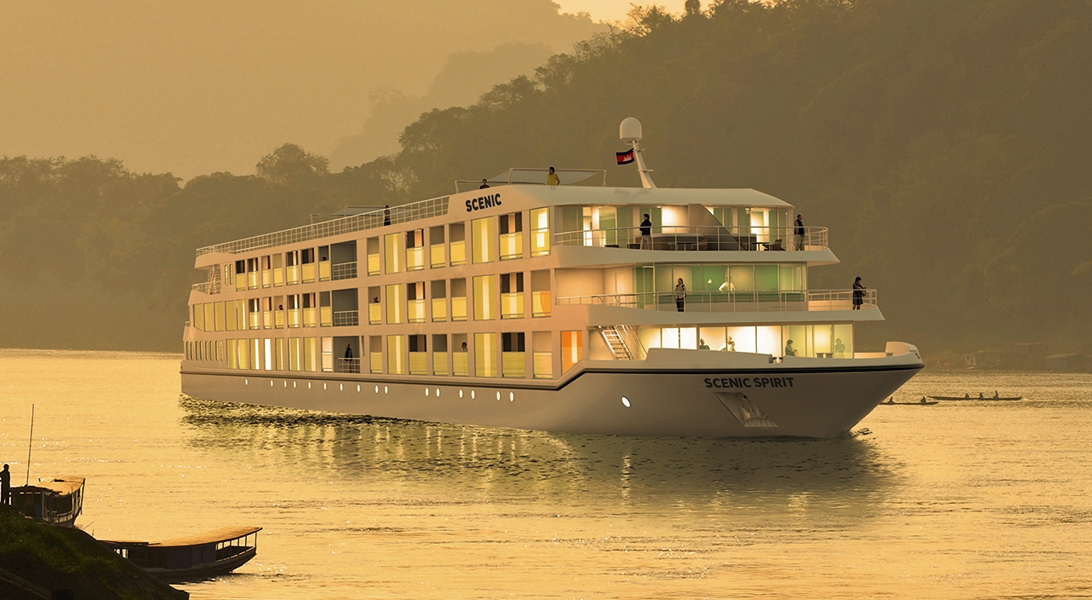





The images shown are for illustration purposes only and may not be an exact representation of what you find on the ship.
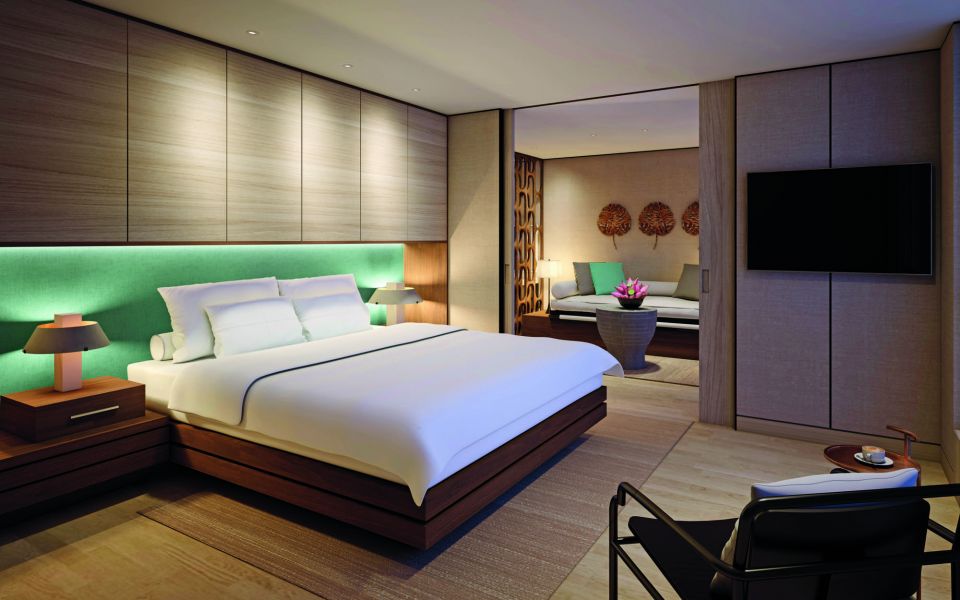
Our Deluxe Suites are the most spacious lead-in suites on the Mekong and Tonle Rivers, featuring a separate bedroom and lounge area, offering modern and elegant furnishings, HDTV and individual room climate control, each with its own control panel.
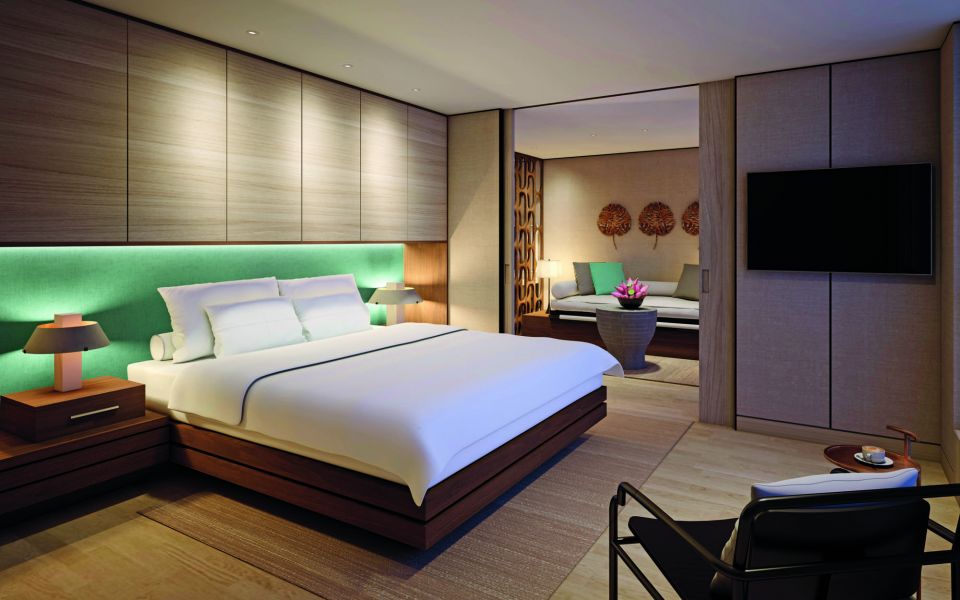
Our expansive Grand Deluxe Suites, at a generous 40 sqm, feature stylish lounge areas, spacious bathrooms, queen-size Scenic Slumber beds, a full walk through wardrobe, HDTV and individual room climate control, each with its own control panel.
As well as all the inclusions entitled to Diamond Deck guests of complimentary pressing of two pieces of clothing per day and breakfast in their suite, you will have fresh fruit delivered to your suite in the afternoon, canapes before dinner and petit fours for after. Also enjoy Club floor privileges at Caravelle Saigon and historic Landmark rooms at Raffles Grand hotel d’Angkor in Siem Reap.
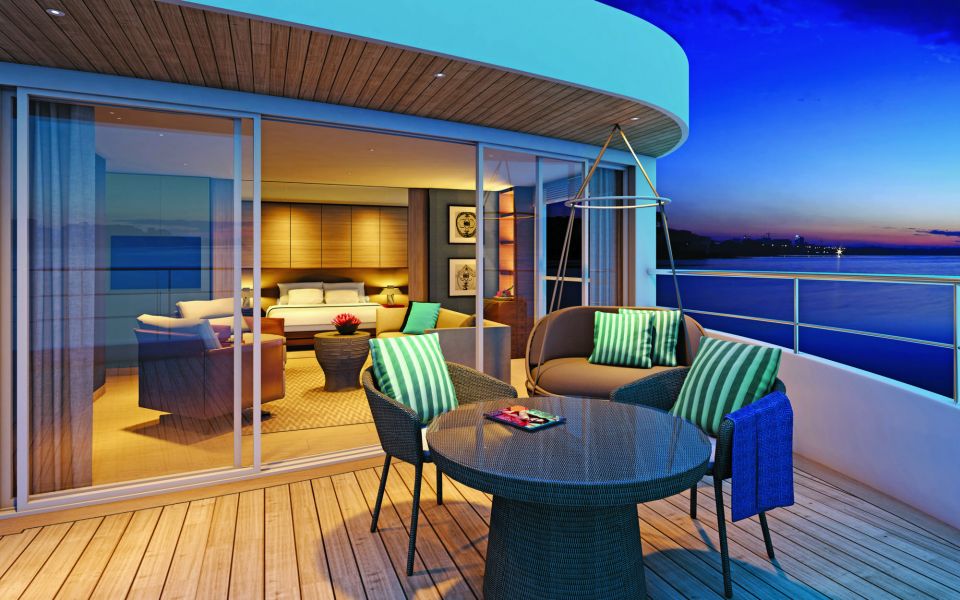
Our expansive Royal Panorama Suites, at a generous 861 sqft, redefine the industry standard. The suites feature elegant lounge areas, oversized bathrooms, with a bath and a private terrace featuring an outdoor Jacuzzi and day bed. You will be welcomed on board with a bottle of French champagne and you won’t even have to unpack or run yourself a scented bath, your butler will do it for you. Enjoy unlimited complimentary laundry services and a US$100 per couple on board Wellness Centre credit. Also enjoy Club floor privileges at Caravelle Saigon and historic Landmark rooms at Raffles Grand hotel d’Angkor in Siem Reap.
The images shown are for illustration purposes only and may not be an exact representation of what you find on the ship.
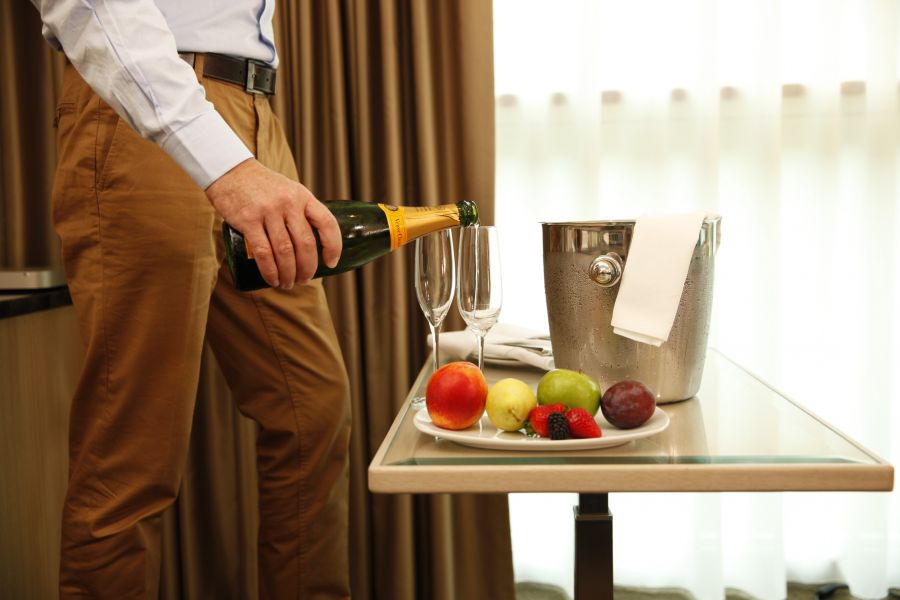
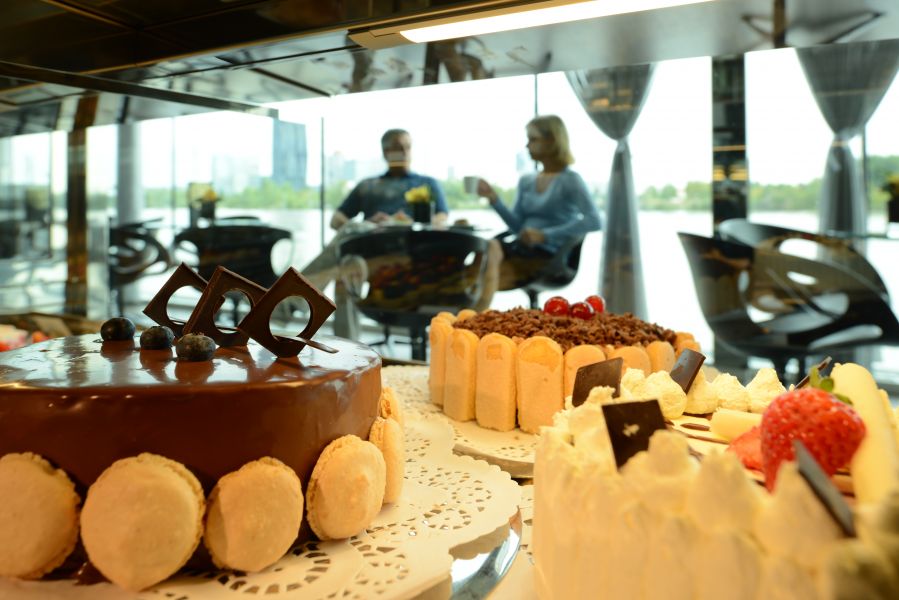
The River Café provides you with a wonderful range of complimentary delicious light meals, snacks and refreshments that you can take anywhere at any time.
The images shown are for illustration purposes only and may not be an exact representation of what you find on the ship.
The images shown are for illustration purposes only and may not be an exact representation of what you find on the ship.
The images shown are for illustration purposes only and may not be an exact representation of what you find on the ship.
| Return flights including luggage allowance | |||
| Overseas Transfers | |||
| 25 nights cruising on the Mekong | |||
| Return airport transfers | |||
| All alcoholic & non alcoholic beverages included | |||
| Gratuities Included | |||
| Choice of shore excursions In each port | |||
| Exclusive special events | |||
| GPS Guides for independent trips ashore | |||
| Speciality restaurants included | |||
| Bikes for passenger use | |||
| Butler Service | |||
| In-room Mini Bar | |||
| Room Service | |||
| Free Wi-Fi Included | |||
| Port Taxes and Fees | |||
 | ABTA and ATOL Protection* | ||
Date 3rd May 2025 |
Nts 25 |
Please Call for Availability |
Date 3rd May 2025 |
Nts 25 |
Please Call for Availability |
Fusion Cruises when selling travel arrangements is a trading name of The Midcounties Co-operative Ltd. Fusion Cruises is an Accredited Body Member of Midcounties Co-operative Travel Consortium. (ABTA:P6652, ATOL:6053).
Book with Confidence. We are a Member of ABTA which means you have the benefit of ABTA’s assistance and Code of Conduct.
Some of the flights and flight-inclusive holidays on this website are financially protected by the ATOL scheme but ATOL protection does not apply to all holiday and travel services offered on this website. This website will provide you with information on the protection that applies in the case of each holiday and travel service offered before you make your booking. If you do not receive an ATOL Certificate then the booking will not be ATOL protected. If you do receive an ATOL Certificate but all parts of your trip are not listed on it, those parts will not be ATOL protected. Please see our booking conditions for information, or for more information about financial protection and the ATOL Certificate go to: www.caa.co.uk
